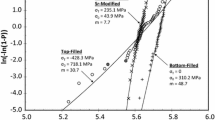Abstract
The work contained herein examines the effect of liquid metal quality, solidification rate, tensile test sample extraction and tensile test preparation, on tensile result reliability as measured using Weibull Statistics. The prototype test casting used for this study was made from sand with two possible sized chills. The level of dissolved hydrogen was examined; as were tensile test sample placement within a cast structure having a gradient of structural fineness imposed by the chill, the effect of increase chill mass, and the effect of sample preparation, on the Weibull Modulus. The test sample population for each iteration was thirty samples, which is reasonable for a Weibull modulus to be determined. A detailed metallographic analysis of the tensile bar fracture surfaces was determined using Light Optical Microscopy (LOM) and Scanning Electron Microscopy in Secondary Electron (SEM/SE) mode.
Similar content being viewed by others
References
Gruzleski J.E. & Closset B.M., The Treatment of Liquid Aluminum-Silicon Alloys, American Foundrymen’s Society, Inc. (1990).
Zalensas D.L. (ed.), Jorstad J.L., Rasmussen W.M. (Revised by) Aluminum Casting Technology, 2nd Ed., American Foundry Society, Inc., p 201 (1993).
Djurdjevic M., Stockwell T. and Sokolowski J.H., “The Effect of Strontium on the Microstructure of Aluminum-Silicon and Aluminum-Copper Eutectics in the 319 Alloy”, International Journal of Cast Metals Research, vol. 12, pp 67–73 (1997).
Bäckerud L., Chai G., Tamminen J., “Solidification Characteristics of Aluminum Alloys” vol. 2, Foundry Alloys, AFS/Skanaluminum, pp 255 (1990).
Boileau J.M., Zindel J.W. & Allison J.E., “The Effect of Solidification Time on the Mechanical Properties of A356-T6 Aluminum Alloys,” SAE Paper # 970019 (1997).
Crepeau P.N., “Effect of Iron in Al-Si Alloys: A Critical Review”, AFS Transactions, vol. 103, pp 361–366 (1995).
Gustafsson G., Thorvaldsson T. & Dunlop G.L., “The Influence of Fe and Cr on the Microstructure of Cast Al-Si-Mg Alloys”, Metallurgical Transactions A, vol. 17A, pp 45–52 (1986).
Bäckerud L., Krol E. & Tamminen T., “Solidification Characteristics of Aluminum Alloys”, vol. 1: “Wrought Alloys”, AFS/Skanaluminum, pp 156 (1996).
Mulazimoglu M.H, Zaluska A., Gruzleski J. E. & Paray F., “Electron Microscope Study of Al-Fe-Si Intermetallics in 6201 Aluminum Alloy”, Metallurgical & Materials Transactions A, vol. 27, no. 4, pp 929–936 (1996).
Arnberg L., Bäckerud L. & Chai G., “Solidification Characteristics of Aluminum Alloys”, vol. 3: “Dendrite Coherency”, AFS/Skanaluminum, pp 247 (1996).
Bäckerud L., Chai G., Tamminen J., “Solidification Characteristics of Aluminum Alloys” vol. 2, Foundry Alloys, AFS/Skanaluminum, pp 255 (1990).
Mulazimoglu M.H., Tenekedjiev N., Closset B.M., Gruzleski J.E., “Microstructure and Thermal Analysis of Strontium Treated Aluminum-Silicon Alloys”, American Foundry Society, Inc., pp 116 (1997).
Gruzleski J.E., “Microstructure Development during Metalcasting”, American Foundrymen’s Society, Inc., pp 236 (2000).
Staley Jr. J.T., Tiryakioglu M, Campbell J, “The Effect of Increased HIP Temperatures on Bifilms and Tensile Properties of A206-T71 Aluminum Castings”, Materials Science and Engineering: A, vols. 460-461, pp 324–334 (July 2007).
Byczynski E., The Strength and Fatigue Performance of 319 Aluminum Alloy Castings, Ph.D. Dissertation, School of Metallurgy and Materials — University of Birmingham (2002).
Green N. R., Campbell J., Influence of Oxide Film Filling Defects on The Strength of Al-7Si-Mg Alloy Castings, AFS Transactions, vol. 102, p 341 (1995).
Weibull W., A Statistical Distribution of Wide Applicability, Journal of Applied Mechanics, vol. 18, p 293 (1951).
Anson J.P. & Gruzleski J.E., “A Quantitative Evaluation of the Effect of Hydrogen Content on the Relative Amounts of Shrinkage and Gas Microporosity in a Cast Al-7% Si Foundry Alloy”, AFS Transactions, vol. 107, pp 456–467 (1999).
Author information
Authors and Affiliations
Rights and permissions
About this article
Cite this article
MacKay, R., Szablewski, D. The Use of the Weibull Statistical Method to Assess the Reliability of a Development Engineered Casting Component. Inter Metalcast 4, 31–45 (2010). https://doi.org/10.1007/BF03355484
Published:
Issue Date:
DOI: https://doi.org/10.1007/BF03355484




